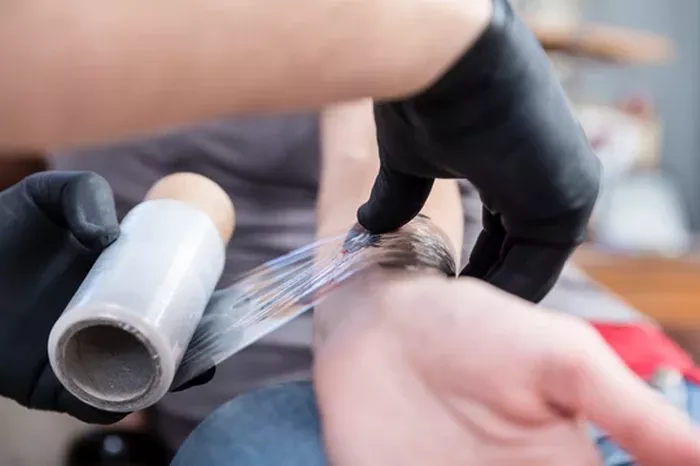Getting a tattoo is an exciting experience, but proper aftercare is crucial to ensure that your tattoo heals well and looks great. One of the first steps in tattoo aftercare is understanding how long to leave your tattoo wrap on. This article provides an in-depth look at tattoo wrapping, including the materials used, recommended durations, and additional tips to ensure optimal healing.
What is Tattoo Wrapping?
Tattoo wrapping is the practice of covering a fresh tattoo with a protective layer immediately after it has been completed. The primary purpose of tattoo wrapping is to protect the new tattoo from external elements such as dirt, bacteria, and physical trauma. It also helps to keep the area clean and reduces the risk of infection during the initial stages of healing.
Importance of Tattoo Wrapping
Protection from Bacteria: The wrap acts as a barrier against bacteria and other contaminants that could potentially cause infection.
Prevention of Physical Damage: It helps shield the tattoo from knocks, bumps, and other physical disturbances that could affect the healing process.
Fluid Control: Wrapping can contain the initial fluid oozing from the tattoo, which is a normal part of the healing process.
Materials Used for Tattoo Wrapping
1. Plastic Wrap (Cling Film)
Characteristics:
Transparency: Plastic wrap is transparent, allowing you to see the tattoo while it’s wrapped. This can be useful for checking the tattoo without removing the wrap.
Efficiency: It is effective at keeping out bacteria and contaminants, providing a protective layer over the fresh tattoo.
Moisture Management: While plastic wrap helps to keep the tattoo protected, it can trap excess moisture if left on for too long. This may lead to maceration of the skin, which can hinder the healing process.
Duration: 2-4 Hours
Initial Protection: Plastic wrap should be used for the initial hours after the tattoo session. This helps protect the tattoo from immediate exposure to the environment and allows for the initial healing process to begin.
Removing the Wrap: After the recommended time, gently remove the plastic wrap. Wash the tattoo with a mild, fragrance-free soap and pat it dry with a clean towel before applying a thin layer of tattoo-specific aftercare ointment.
Potential Issues: Leaving plastic wrap on for too long can cause moisture buildup and increase the risk of bacterial growth. Ensure that the wrap is removed within the recommended time frame to avoid these issues.
2. Cloth Bandages
Characteristics:
Breathability: Cloth bandages are breathable, allowing air circulation which can help prevent excess moisture buildup.
Absorption: They are effective at absorbing excess fluid from the tattoo, which can reduce the risk of moisture-related issues.
Protection: Cloth bandages offer a degree of protection against physical damage and bacteria while allowing the skin to breathe.
Duration: 2-4 hours
Recommended Time: Cloth bandages are typically left on for a similar period as plastic wrap, usually around 2-4 hours. However, their breathable nature may make them suitable for slightly longer periods, especially if recommended by your tattoo artist.
Changing the Bandage: If you choose to use a cloth bandage, replace it with a fresh one if it becomes saturated or if you need to sleep with it on.
SEE ALSO: How to Protect Hand Tattoos at Work
3. Protective Tattoo Film
Characteristics:
Advanced Protection: This type of film is designed specifically for tattoo aftercare. It provides a protective barrier against bacteria, dirt, and moisture.
Extended Wear: It is typically more durable and can stay on longer than plastic wrap or cloth bandages without compromising the healing process.
Duration: 3-5 Days
Extended Protection: Protective tattoo films offer a longer-lasting protective barrier. They can be left on for 3-5 days, allowing for continuous protection while facilitating the healing process.
Removal: After the specified period, carefully remove the film and follow the cleaning and moisturizing instructions provided by your tattoo artist.
Follow Artist’s Advice: Always follow the specific instructions provided by your tattoo artist regarding the duration of the protective film.
Additional Tips
Avoid Vigorous Physical Activity
Prevent Excessive Sweating: While your tattoo is wrapped, try to avoid vigorous physical activity that may cause excessive sweating. Sweat can seep under the wrap, potentially leading to skin irritation or infection.
Manage Physical Activities: If you need to engage in physical activities, consider removing the wrap for a short period, ensuring you clean and reapply it properly afterward.
Sleeping with the Wrap
Changing the Wrap: If you plan to sleep with the wrap on, consider changing it in the morning to prevent any moisture buildup and ensure cleanliness.
Comfort and Hygiene: Using a clean, breathable wrap while sleeping can help keep the tattooed area comfortable and reduce the risk of complications.
Conclusion
Proper tattoo wrapping and aftercare are crucial steps in ensuring that your new tattoo heals well and maintains its appearance. By understanding the different materials used for wrapping, adhering to the recommended durations, and following additional tips for managing physical activity and sleep, you can help ensure that your tattoo heals effectively. Remember, always consult with your tattoo artist for personalized advice and follow their recommendations for the best results. With the right care, your tattoo will remain vibrant and well-preserved for years to come.
Related Topics

